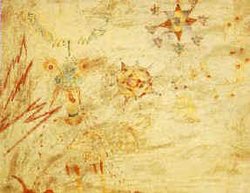Lucy in the Sky with Diamonds
|
|
Lucy in the Sky with Diamonds is a song written mostly by John Lennon (with some material by Paul McCartney) in 1967 and recorded by The Beatles for their album, Sgt. Pepper's Lonely Hearts Club Band.
| Contents |
Julian's drawing
According to the Beatles, one day in 1966 Lennon's son Julian came home from nursery school with a drawing he said was of his classmate, a girl named Lucy. Showing the artwork to his father, young Julian described the picture as "Lucy - in the sky with diamonds."
Julian later said, "I don't know why I called it that or why it stood out from all my other drawings but I obviously had an affection for Lucy at that age. I used to show dad everything I'd built or painted at school and this one sparked off the idea for a song about Lucy in the sky with diamonds."
His son's artwork appears to have inspired Lennon to draw heavily on his own childhood affection for Lewis Carroll's Wool and Water chapter from Through the Looking-Glass. At least one lyric was influenced by both Carroll and skits on a popular British comedy programme (the Goon Show) making references to plasticine ties, which showed up in the song as Plasticine porters with looking glass ties. Carroll's work has also been cited as having influenced Lennon's two books, In His Own Write and A Spaniard in the Works.
Who was Lucy?
Four year old Lucy Richardson was about a year older than Julian Lennon when he enrolled at the private Heath House School in Weybridge, Surrey. John Lennon and the other Beatles visited her family's antique and jewellery shop now and then, so the family knew Julian and when the little boy became homesick or unsettled at school Lucy would be called out of class to sit with him while he drew pictures.
In 2005 her sister Mary Foster said, "One day John Lennon came into the shop and said, 'Hello, Lucy in the sky with diamonds.' We thought it was just John being John." When the song appeared on 1967's Sgt Pepper's Lonely Hearts Club Band album the Richardsons noticed the name but weren't sure of any connection until 1975 when Lennon said in an interview he had been inspired by his son's picture of a girl named Lucy.
Richardson went on to work in the film industry and is credited as art director on films such as Elizabeth with Cate Blanchett and Geoffrey Rush, Chocolat and The Life and Death of Peter Sellers. She never married. In 2003 she was diagnosed with breast cancer. After gruelling therapy the cancer reportedly spread to her bones and she died on 1 June, 2005.
When she was buried in Weybridge her family sprinkled crystals on the grave, symbolizing the song's title.
Reference to drugs
Since the initials of the title are LSD and the lyrics are psychedelic, some have suggested the song refers to drug use and there was some controversy surrounding this when the recording was first released and getting airplay. While Lennon and the Beatles were often frank about their drug use, for decades they denied the song had anything to do with LSD. However, during a newspaper interview in 2004 McCartney was quoted as saying, "Day Tripper, that's one about acid. Lucy in the Sky, that's pretty obvious. ...There's others that make subtle hints about drugs, but, you know, it's easy to overestimate the influence of drugs on the Beatles' music."
Cultural echos
The song has since been covered by many artists, as have dozens of Beatles songs. A 1968 version by Canadian actor William Shatner (included on his album The Transformed Man) wasn't successful at the time but became well-known on the Internet decades later. Reportedly, in both informal and more structured polls of music fans, Shatner's rendition is considered one of the worst pop recordings ever, although the notoriety has perhaps only helped his musical career. A more critically successful remake was recorded in 1974 by Elton John with background vocals and guitar by John Lennon (who used the pseudonym Dr. Winston O'Boogie) This version was released as a single and topped the Billboard pop charts for two weeks in January 1975.
The song inspired the name of an anthropological find. On November 30, 1974, Donald Johanson and Tom Gray discovered the skeleton of a 3.18 million year old female hominid in the Afar Triangle of Ethiopia. They called it Lucy because the Beatles hit was playing on the radio when they were discussing a name.
On 13 February, 2004 astronomers at Harvard announced the discovery of BPM 37093, a celestial object which appears to be a carbon star, in effect a huge 1x1034 carat diamond (2x1030 kg). They whimsically named it Lucy, likely in reference to the giant diamond in Arthur C. Clarke's 2061: Odyssey Three named Lucy in the Sky with Diamonds.
External links
- Song lyrics (http://frogcircus.org/beatles/sgt_peppers_lonely_hearts_club_band/lucy_in_the_sky_with_diamonds)
- Lyrics and Chords (http://www.guntheranderson.com/v/data/lucyinth.htm)
- Article about Lucy Richardson (http://www.entertainment.news.com.au/story/0,10221,15627577-7484,00.html|2005)

| Missing image Jk_beatles_paul.jpg Paul McCartney | The Beatles | 
| 
| ||
|---|---|---|---|---|---|---|
|
History of the Beatles | Long-term influence | British Invasion | Classic rock era | Paul is Dead rumours | Apple Records | George Martin | Geoff Emerick | Brian Epstein | Beatlesque | Discography | Bootlegs | Beatlemania | ||||||

